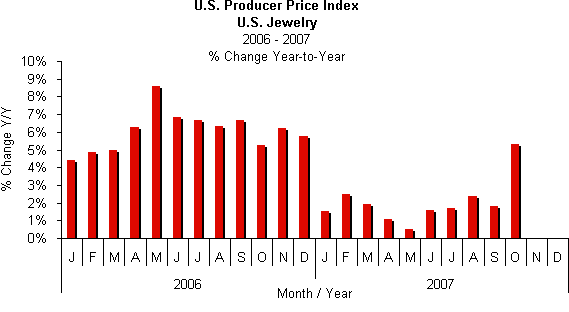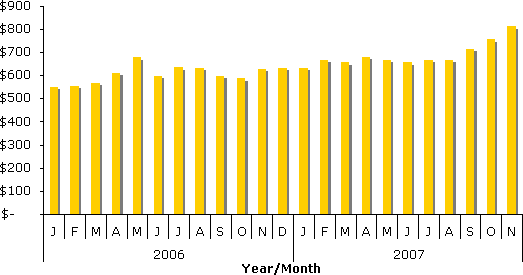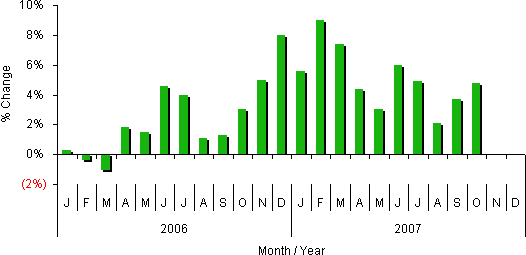IDEX Online Research: U.S. Jewelry Prices Rise Sharply in October
November 26, 07
Jewelry prices spiked upward at both the retail level and the supplier level in the U.S. market during October, according to the latest data from the U.S. Bureau of Labor Statistics (BLS). Both jewelry retailers and suppliers have been fighting higher costs for much of the year, and it is clear that those higher costs are now being passed along the distribution chain, all the way through to the consumer.
What is behind these sharply rising prices? Mostly, it is higher gold prices, along with higher prices for other precious metals. Diamond prices have been rising, but not at the torrid pace of gold price increases.
- Jewelry Producer Prices +5.3 percent in October – Jewelry producer prices rose by a dramatic 5.3 percent in October 2007, as calculated by the BLS. This year-to-year measure compares producer prices for a market basket of jewelry in October 2007 to the same period in 2006. Up until October, price inflation at the supplier level had been running at about 1.7 percent on average for each month of 2007; this was about in line with historic levels of producer price inflation. However, the sharp spike in supplier prices in October has raised this year’s average producer price inflation rate to about 2 percent, a level which is at the top end of historic trends. It is clear that suppliers are both unable and unwilling to continue to absorb higher materials prices, and they passed those prices on to retailers in October.
- Jewelry Consumer Prices +4.8 percent in October – Continuing a three-month trend of rising inflation, jewelry consumer prices – the retail price of jewelry in stores – rose by 4.8 percent in October 2007 versus the same period in 2006, according to the latest statistics from the BLS. Jewelry price inflation has been jumping all over in 2007 – up sharply one month followed by a dizzying decline the following month. When these sharp cycles are smoothed, the bottom line is this: jewelry retail prices have risen by just over 5 percent in 2007. Retail prices of jewelry are up due to higher precious metals cost as well as due to higher producer prices for finished goods. If retail jewelry prices rise by more than 5 percent in 2007, it will be the highest inflation rate for the American jewelry industry since 1990.
We believe that retail prices for jewelry will continue to rise in the remaining months of 2007. For the full year, it is likely that retail prices for jewelry will increase by at least 5 percent, somewhat above our earlier forecast. Our outlook for total jewelry sales in the U.S. this year – +3 percent or so – is now well below the jewelry industry inflation rate. Thus, we expect unit sales of jewelry to be down for the year, when compared to 2006.
Jewelry Producer Prices Spike in October
After languishing under 2 percent for most of 2007, jewelry prices at the producer level jumped by a dramatic 5.3 percent in October. Earlier, we had expected jewelry suppliers to implement only moderate price increases due to the uncertainty relating to jewelry demand, especially in the face of a soft retail environment during the 2007 holiday selling season. However, as gold prices have continued to rise, suppliers have not longer been able to absorb increased precious metals costs; they are now passing them on to jewelry retailers.
The graph below summarizes monthly jewelry producer price inflation since the beginning of 2006. The figures are based on year-to-year comparisons of the BLS jewelry Producer Price Index.

Source: BLS
Jewelry Retail Price Inflation Rate Rises
For the third consecutive month, retail prices for jewelry in the American market have risen at a greater rate. During October, jewelry prices at the retail level were up 4.8 percent. This compares to August price inflation of 2.1 percent, followed by September’s price increase of 3.7 percent.
The primary culprit driving higher retail prices is gold. In our sample of jewelers, they have priced their gold jewelry assuming a gold price of about $550-600. With gold well above that level (about $780 per ounce, as we write this, somewhat below the peak of about $840 earlier this month), jewelers have been shocked by the costs of gold jewelry which they have been re-ordering to replace pieces which have sold. As a result, retailers are being forced to adjust their retail prices higher to cover rising gold prices.
The graph below illustrates the rising cost of gold in U.S. dollars. As the graph illustrates, the price of gold has risen sharply over the past three months, after remaining relatively flat for most of the summer.
Gold Price Trends
Average Monthly Price per Ounce
2006-2007
Source: Market
The graph below summarizes the percentage change in retail prices of jewelry and watches by month on a year-to-year basis since 2006. The percent change is based on a comparison to the same month a year ago.
U.S. Consumer Price Index for Jewelry
U.S. Retail Jewelry & Watch Prices
2006 - 2007
% Change Year-to-Year
Source: BLS
Forecast: Inflation Rate Will Remain Elevated, As Long As Materials Prices Rise
For the remaining months of 2007, we expect retail jewelry prices to stabilize, followed by a return of inflationary pricing – perhaps significant inflationary pricing – in 2008. Near term, there are two key reasons why we believe retail jewelry prices will stabilize:
- Most jewelers have already determined the retail prices for the holiday selling season; their promotional flyers have been printed, so the prices are already set. Unfortunately, their gold prices reflect costs of about $600-700 per ounce for the chains, and $500-600 for the independent merchants.
- With relatively soft jewelry sales so far in 2007 at the mass market level, we believe jewelers are reluctant to raise retail prices much further for fear of losing sales.
Longer term, jewelry prices will rise due to two major factors:
- Commodity prices continue to increase. As precious metals prices rise, those costs will be passed along to consumers.
- Jewelers’ margins are squeezed. If jewelers – retailers and suppliers – are to make a reasonable return on their invested capital, they will need to raise prices to improve long term profits.